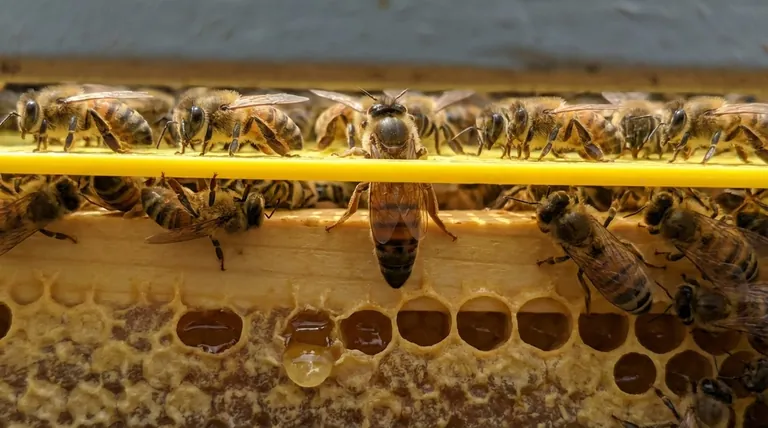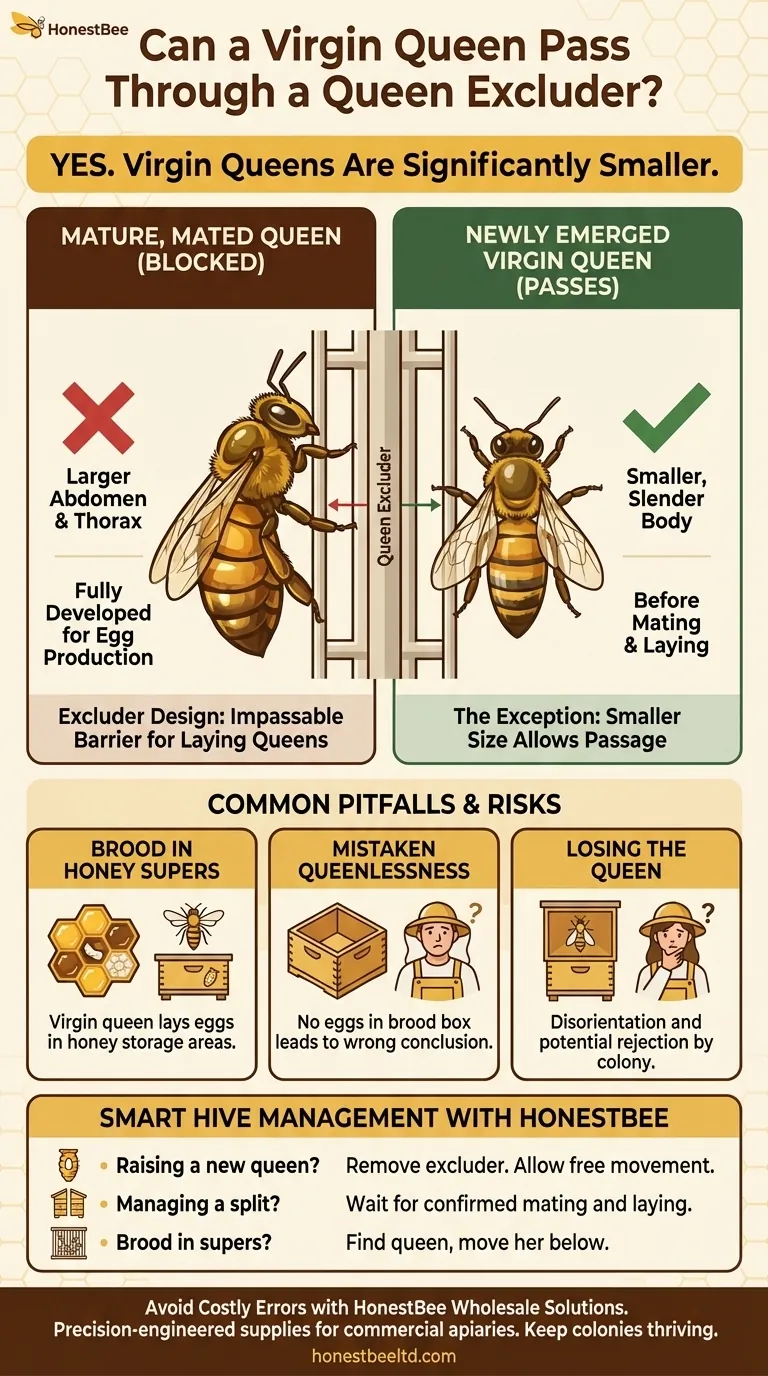Yes, a virgin queen can often pass through a standard queen excluder. While an excluder is designed to be an impassable barrier for a queen, it is calibrated for the size of a mature, mated, and laying queen. A newly emerged virgin queen is significantly smaller and more slender, allowing her to slip through the gaps workers use.
A queen excluder is a tool that relies entirely on a size difference. This tool fails when that size difference doesn't exist, which is precisely the case with a smaller, unmated virgin queen compared to her mature, mated counterpart.

The Principle of the Queen Excluder
To understand the exception, we must first understand the rule. A queen excluder is a simple but critical piece of beekeeping equipment designed with one goal in mind.
How It Works: A Matter of Size
A queen excluder is a grid with gaps precisely measured to be between 4.1 and 4.4 millimeters.
These gaps are large enough for smaller worker bees to pass through without issue. However, they are designed to be too narrow for a mature queen bee's larger thorax and abdomen.
The Intended Purpose
By placing an excluder between the lower brood boxes and the upper honey "supers," a beekeeper confines the queen to the brood area.
This ensures she lays eggs only where desired, keeping the honey supers dedicated solely to honey storage and free of eggs, larvae, and pupae.
Why a Virgin Queen Is the Exception
The entire system breaks down when a new, unmated queen is present in the hive. Her physical characteristics are fundamentally different from those of the mature queen the excluder was designed to stop.
The Physical Difference
A virgin queen has not yet begun egg production. Her abdomen is small and slender, not much larger than a worker's.
A mated, laying queen has fully developed ovaries and carries eggs, making her abdomen significantly larger, longer, and heavier. This mature size is what prevents her from passing through the excluder.
The Thorax is Key
While the abdomen is the most visibly different part, the critical barrier is the thorax (the bee's mid-section). A virgin queen's thorax is small enough that she can often squeeze her entire body through the excluder's gaps.
Implications for Mating Flights
A virgin queen must be able to leave the hive for her mating flights. If she emerges in a hive and finds her path to the entrance is blocked by an excluder (an uncommon but possible configuration), she will be trapped. More commonly, she can move freely throughout the entire hive, including into the honey supers, before she is large enough to be contained.
Common Pitfalls and Management Risks
This size difference isn't just a piece of trivia; it creates significant practical risks for the beekeeper who is unaware of it.
Brood in the Honey Supers
The most common problem is a virgin queen passing through the excluder, taking her mating flights, and then starting to lay eggs in the honey supers. This defeats the entire purpose of the excluder and can lead to a messy mix of honey and brood in frames intended for harvest.
Mistaken Queenlessness
A beekeeper might inspect the brood box, see no new eggs, and wrongly conclude the hive is queenless. In reality, the new queen may be healthy and laying, but in the supers above the excluder. This can lead to a disastrous attempt to introduce a new queen into a hive that already has one.
Losing the Queen
Less commonly, a virgin queen may wander into the supers, become disoriented, and fail to find her way back down to the main cluster in the brood box. This isolation can lead to her failure or rejection by the colony.
Making the Right Choice for Your Hive
Your management strategy must adapt to the presence of a virgin queen. Do not assume the queen excluder will work as intended until she is fully mated and laying.
- If your primary focus is raising a new queen: Remove the queen excluder entirely. Allow her to move freely, complete her mating flights, and establish a solid laying pattern in the brood box before you consider reinstalling it.
- If your primary focus is managing a recent split or swarm cell: Wait until you can confirm the new queen is mated and laying consistently. Only after verifying a good brood pattern in the correct location should you add the queen excluder.
- If you suddenly find brood in your honey supers: Your first suspicion should be a new queen who passed through the excluder. Your immediate task is to find her and place her below the excluder to re-establish a proper brood nest.
Understanding this crucial exception is the key to using a queen excluder effectively and avoiding costly hive management errors.
Summary Table:
| Scenario | Can the Queen Pass? | Key Reason |
|---|---|---|
| Mature, Laying Queen | No | Larger thorax and abdomen from egg production. |
| Virgin Queen | Yes | Smaller, slender body before mating and laying. |
Avoid costly hive management errors with the right equipment from HONESTBEE.
Our wholesale-focused operations supply commercial apiaries and distributors with durable, precision-engineered beekeeping supplies. Ensure your queen excluders and other tools are optimized for effective hive management.
Contact HONESTBEE today to discuss your wholesale needs and keep your colonies thriving.
Visual Guide

Related Products
- Professional Plastic Queen Excluder for Modern Beekeeping
- Wooden Queen Bee Excluder for Beekeeping
- Premium Wood Framed Metal Wire Queen Bee Excluder
- Metal Queen Bee Excluder for Beekeeping
- High Performance Plastic Queen Excluder for Beekeeping and Apiary Management
People Also Ask
- Why are queen excluders recommended for Flow Hives? Prevent Brood Damage for a Clean Harvest
- What is a Queen Excluder and how does it work? Achieve Purer Honey & Better Hive Control
- What is the role of a queen excluder when adding a super? Ensure Brood-Free Honey Harvests
- What are the pros of using a queen excluder? Boost Hive Control & Honey Quality
- How do queen excluders work in terms of spacing and bee movement? A Guide to Precision Hive Management



















